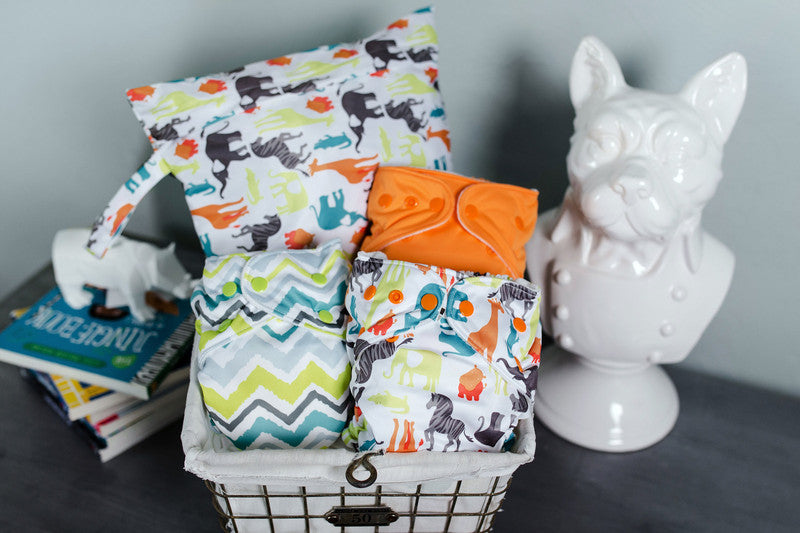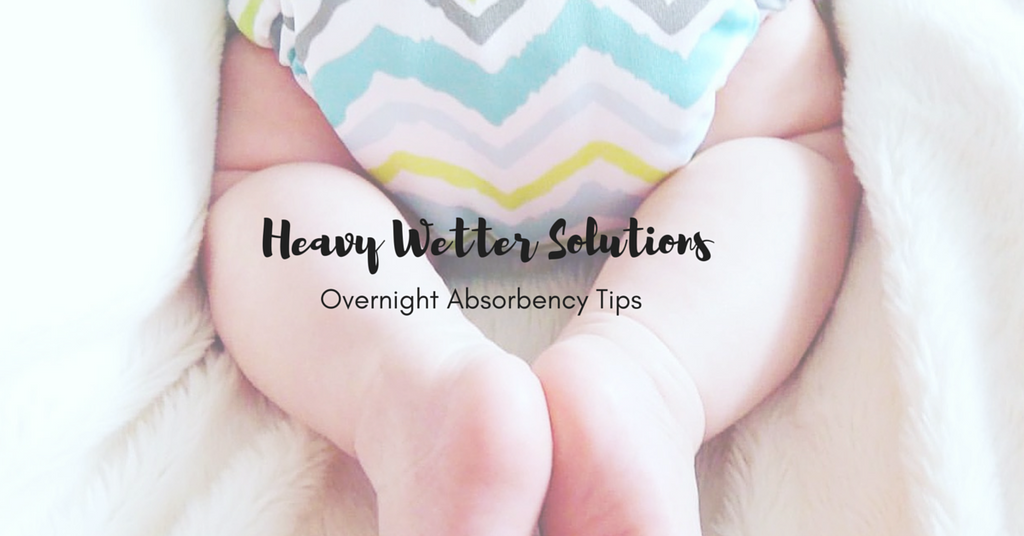Every child is different in many ways, and this includes potty habits! Some kids trickle here and there throughout the day, while others flood their diapers all in one “go.” So when using cloth diapers, it’s important to pay attention to this as you may need to adjust your system accordingly.
When dealing with heavy wetters, especially overnight, absorbency and fit are key to a successful cloth diapering experience. Figuring out which materials to use, in what combination, and when, can make all the difference in whether or not you end up with leaks.
Let’s be clear on one thing: Leaks can happen anywhere, and at any time. They are the number one complaint among cloth diaper users of any brand and any type, but just about any chronic leaking issue can be remedied with a few adjustments.
So let’s talk absorbency. This is one of the most important aspects of leak-free cloth diapering, and one that is often overlooked when dealing with it. Just because a particular cloth diaper comes with one particular insert, that doesn’t always mean that it’s going to work for your child. Let’s take a look at the most common materials used for absorbency, and how each one functions:
Microfiber - This is perhaps the most popular material making up a good majority of cloth diaper inserts. A synthetic fiber, microfiber is very “thirsty” and is also known to absorb quickly. It is known to last longer than natural fibers like hemp or bamboo, which is a plus because aside from potentially being able to use the same inserts through multiple children, it is also non-biodegradable so the longer you can use it, the better. The downsides of microfiber is that it is prone to compression leaking, and can also hang on to odors and build-up, often resulting in repelling and leaking issues.
Cotton - Fairly inexpensive and very absorbent. You can find cotton absorbency in the form of cheap prefolds and flats, and also with flour sack towels which have become a popular insert option. Cotton is much less prone to compression leaks than microfiber (which is honestly probably the worst offender). Cons include a slower drying time, and - if not organic - is usually grown in pesticides and/or fertilizers.
Hemp - Probably absorbs the most liquid out of all natural fibers. It is highly sustainable due to how fast it grows, and without the need of pesticides or other chemicals. Cons are that even though it is highly absorbent, it is slow to absorb so hemp tends to work best when combined with other fibers or with another insert (also known as “doubling”). It also has the potential to hang on to odors similar to microfiber. Unprocessed hemp is usually very crunchy when dried on the line so if this irks you, you may want to dry in the dryer.
Bamboo - This is another very absorbent material that can be grown quickly without chemicals, but must be highly processed in order to turn bamboo fibers into usable fabric so in the end, it isn’t a truly “natural” material (though still more natural than microfiber). Bamboo is also less likely to hold on to odors the way hemp and microfiber can, and stays softer than hemp when dried. Bamboo makes a great overnight solution, especially when using a bamboo flannel or fleece insert.
When trying to figure out what inserts are best to use for your child, pay attention to their “potty language.” How long can you usually leave the diaper on before it needs to be changed? If you can go for a few hours, then your child most likely has fewer bowel movements throughout the day and tends to pee in trickles instead of gushes. For daytime use, one insert is probably enough, and any of the above materials can likely be used.
If you only get an hour (or less) out of a diaper before it is soaked, then you’ve probably got a heavy wetter on your hands and will need to adjust the absorbency accordingly. For daytime use, bamboo would be a great choice, especially in the form of bamboo velour or fleece, or blended with another material such as hemp or cotton. I have heard that bamboo charcoal inserts work very well, but I do not have personal experience with these so I can’t give my recommendation. It would be something to check out though if you have a heavy wetter!
You may want to consider doubling up your inserts for super soakers. For instance, placing a fast-absorbing insert such as bamboo over a slower-absorbing insert such as hemp can be a great combo for heavy wetters as the initial gush of urine will become mostly absorbed by the bamboo, and then the excess can roll off the bamboo and get captured by the hemp underneath. This is also a great option for overnights when diaper changes may be fewer and farther-between.
*TIP: If you are regularly getting wicking through the waist or leg seams in your diaper, try drying them on high heat one time (do not do this regularly) and/or use a little waterproof sealant (a.k.a. Seam sealer) such as Atsko Permanent Water Guard. If you use the water guard, we recommend spraying some into a cup or bowl and then “painting” it on with a small paintbrush for a cleaner, more precise application.
Let’s also look at the placement of the absorbency. While you can usually get away with simply laying an insert flat inside of your diaper and being done with it, sometimes you may actually need to place more absorbency in a specific spot (known as the “wet zone”) if you’re seeing a pattern in where your child tends to soak their diaper the most. For boys, it’s important to always point the penis down when putting a diaper on so that they don’t end up leaking out of the top front of the diaper. Boys usually need more absorbency in the front of the diaper, while girls tend to need more absorbency in the middle of the insert. So for a boy, for instance, you may find that folding the front part of the insert over once to give extra layers will work better than a flat insert.
Lastly, always make sure that the diaper fits well. You want a good, snug fit with no gapping or sagging. Check the leg openings and waist area to make sure that these areas are tight, but not so tight that they are leaving painful-looking marks on your child’s body. Light red marks are normal, just like the markings you get on your legs when you remove your socks, or around your waist when you remove your jeans. Check with your diaper brand’s sizing guide to ensure you are adjusting according to their recommended settings, and then you can readjust if necessary.
Hopefully these tips help make your cloth diapering experience a bit easier! Do you have a heavy wetter? If you’ve found your perfect absorbency match, what is it?



